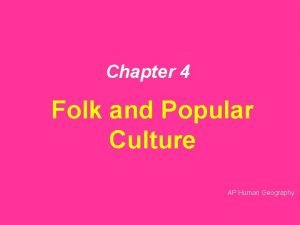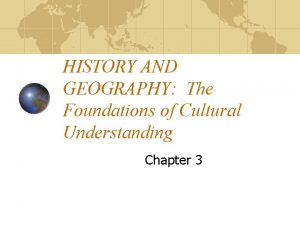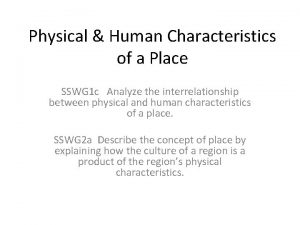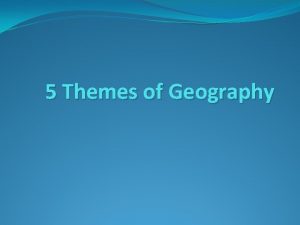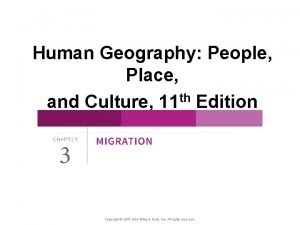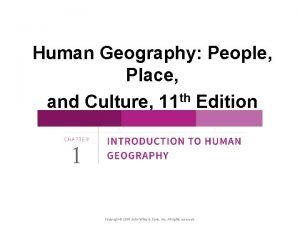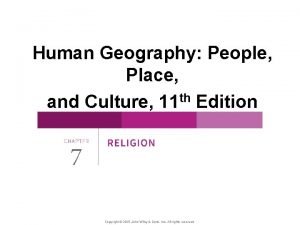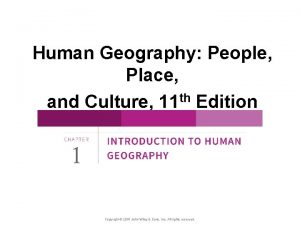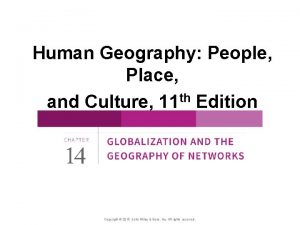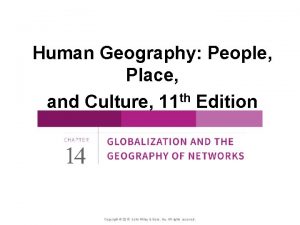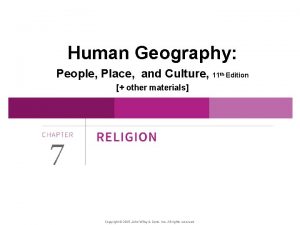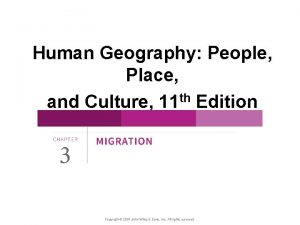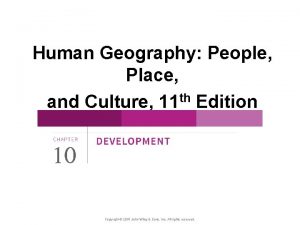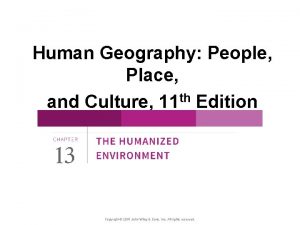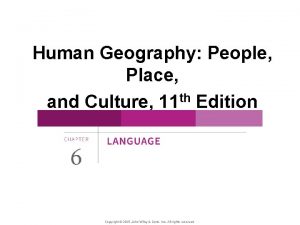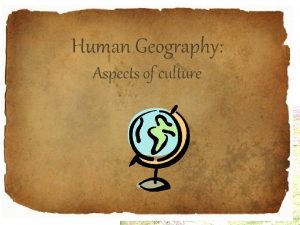Human Geography People Place and Culture 11 th
































- Slides: 32

Human Geography: People, Place, and Culture, 11 th Edition Copyright © 2015 John Wiley & Sons, Inc. All rights reserved.

Chapter 4: Local Culture, Popular Culture, and Cultural Landscapes Copyright © 2015 John Wiley & Sons, Inc. All rights reserved.

Key Question: 1. What are local and popular cultures? Copyright © 2015 John Wiley & Sons, Inc. All rights reserved.

Definitions of Culture • A culture is a group of belief systems, norms, and values practiced by a people. • A group of people who share common beliefs can be recognized as a culture in one of two ways: 1. The people call themselves a culture. 2. Other people (including academics) can label a certain group of people as a culture. Copyright © 2015 John Wiley & Sons, Inc. All rights reserved.

What Are Local & Popular Cultures? • Folk culture is small, incorporates a homogeneous population, is typically rural, and is cohesive in cultural traits. • Popular culture is large, incorporates heterogeneous populations, is typically urban, and experiences quickly changing cultural traits. Copyright © 2015 John Wiley & Sons, Inc. All rights reserved.

What Are Local & Popular Cultures? • A local culture is a group of people in a particular place who see themselves as a collective or a community, who share experiences, customs, and traits, and who work to preserve those traits and customs in order to claim uniqueness and to distinguish themselves from others. • Material culture of a group of people includes things they construct, such as art, houses, clothing, sports, dance, and food. • Nonmaterial culture includes beliefs, practices, aesthetics (what they see as attractive), and values of a group of people. Copyright © 2015 John Wiley & Sons, Inc. All rights reserved.

Hierarchical diffusion: • Can occur through a hierarchy of places • The hearth is the point of origin Figure 4. 2 London, United Kingdom. Catherine Middleton, Duchess of Cambridge, enters Westminster Abbey in a wedding gown reminiscent of Grace Kelly’s. Sarah Burton of the House of Alexander Mc. Queen designed the gown. Members of the Royal School of Needlework hand cut and sewed the intricate lace. The sewers washed their hands every 30 minutes and replaced needles every 3 hours to keep the dress pristine and the work exact. © Samir Hussein/Wire Image. Copyright © 2015 John Wiley & Sons, Inc. All rights reserved.

Employing the concept of hierarchical diffusion, describe how you became a “knower” of your favorite kind of music—where is its hearth, and how did it reach you? Copyright © 2015 John Wiley & Sons, Inc. All rights reserved.

Key Question 2. How are local cultures sustained? Copyright © 2015 John Wiley & Sons, Inc. All rights reserved.

Cultural Assimilation • Assimilation: a policy of the U. S. government in the 1800 s and into the 1900 s to assimilate indigenous peoples into the dominant culture in order to make American Indians into “Americans” rather than “Indians. ” • Canadians, Australians, Russians, and other colonial powers adopted similar policies toward indigenous peoples. • American Indians in the United States are working to push back assimilation and popular culture by reviving the customs of their local cultures. Copyright © 2015 John Wiley & Sons, Inc. All rights reserved.

Cultural Appropriation • Local cultures are sustained through customs, practices that a group of people routinely follow. • A local culture can also work to avoid cultural appropriation, the process by which other cultures adopt customs and knowledge and use them for their own benefit. • Local cultures desire to keep popular culture out, keep their culture intact, and maintain control over customs and knowledge. Copyright © 2015 John Wiley & Sons, Inc. All rights reserved.

Rural Local Cultures • Members of local cultures in rural areas often have an easier time maintaining their cultures because of their isolation. • When a local culture discontinues its major economic activity, it faces the challenge of maintaining the customs that depend on the economic activity and sustaining its culture. • Today, when a local culture decides to reengage in a traditional economic activity or other cultural custom, it can no longer decide in isolation. Copyright © 2015 John Wiley & Sons, Inc. All rights reserved.

How Are Local Cultures Sustained? Case Study: The Makah American Indians • Hunted whales for 1, 500 years, but the U. S. government stopped them in the 1920 s; the gray whale had become endangered. • 1994, NOAA removed the eastern North Pacific gray whale from the endangered list. Copyright © 2015 John Wiley & Sons, Inc. All rights reserved.

How Are Local Cultures Sustained? Case Study: Little Sweden • Lindsborg, Kansas • In the 1950 s, the townspeople began celebrating their Swedish heritage, the local culture of the Swedish immigrants. • Neolocalism seeking out the regional culture and reinvigorating it in response to the uncertainty of the modern world. Copyright © 2015 John Wiley & Sons, Inc. All rights reserved.

Cultural Commodification • the process where cultural elements become regarded as objects to be bought, sold or traded on the world market. • Ethnic Neighborhoods • Question of authenticity follows. Copyright © 2015 John Wiley & Sons, Inc. All rights reserved.

How Are Local Cultures Sustained? Authenticity of Places • The Lost City Figure 4. 9 Sun City, South Africa. The Lost City resort in Sun City evokes the mystical images of Africa described in a legend. © Lindsay Hebberd/Corbis. • Guinness and the Irish Pub Company Figure 4. 10 Dubai, United Arab Emirates. An old Irish truck marks the entrance to an Irish Pub Company pub in Dubai. © Alamy. Copyright © 2015 John Wiley & Sons, Inc. All rights reserved.

What is the last place you went to or the last product you purchased that claimed to be “authentic? ” What are the challenges of defending the authenticity of this place or product while refuting the authenticity of other similar places or products? Copyright © 2015 John Wiley & Sons, Inc. All rights reserved.

Key Question: 3 How is popular culture diffused? Copyright © 2015 John Wiley & Sons, Inc. All rights reserved.

Distance decay vs. time-space compression: • Distance decay, the likelihood of diffusion decreases as time and distance from the hearth increases. • Time–space compression, the likelihood of diffusion depends on the connectedness (in communications and transportation technologies) among places (geographer David Harvey). Copyright © 2015 John Wiley & Sons, Inc. All rights reserved.

Hearths of Popular Culture Establishing a Hearth • Contagious diffusion and hierarchical diffusion • Ex. : the Dave Matthews Band Copyright © 2015 John Wiley & Sons, Inc. All rights reserved.

Manufacturing a Hearth • Reterritorialization of popular culture: a term referring to a process in which people start to produce an aspect of popular culture themselves, doing so in the context of their local culture and place, and making it their own. • Ex. : reterritorialization of hip hop Copyright © 2015 John Wiley & Sons, Inc. All rights reserved.

Replacing Old Hearths with New: Beating out the Big 3 Sports • The Big 3: Football, Basketball, Baseball Surfing (1960 s) Skateboarding (1970 s) Snowboarding (1980 s) Ultimate Fighting (1990 s) • Corporations must create the “new” so that they have something to sell that is “socially desirable. ” Copyright © 2015 John Wiley & Sons, Inc. All rights reserved.

Stemming the Tide of Popular Culture— Losing the Local? • At the global scale, North America, western Europe, Japan, India, and South Korea exert the greatest influence on popular culture at present • North America: movies, television, music, sports, and fast food • Japan: children’s television programs, electronic games, and new entertainment technologies • Western Europe: fashion, television, art, and philosophy • South Korea: television dramas, movies, and popular music • India: movies Copyright © 2015 John Wiley & Sons, Inc. All rights reserved.

Stemming the Tide of Popular Culture— Losing the Local? • The rapid diffusion of popular culture can cause consumers to lose track of the hearth of a good or idea. • When popular culture displaces or replaces local culture, it will usually be met with resistance. • Geographers realize that local cultures will interpret, choose, and reshape the influx of popular culture. Copyright © 2015 John Wiley & Sons, Inc. All rights reserved.

Think about your local community (your college campus, your neighborhood, or your town). Determine how your local community takes one aspect of popular culture and makes it your own. Copyright © 2015 John Wiley & Sons, Inc. All rights reserved.

Key Question: 4 How can local & popular cultures be seen in the cultural landscape? Copyright © 2015 John Wiley & Sons, Inc. All rights reserved.

Cultural Landscape • The visible imprint of human activity on the landscape. • Placelessness: the loss of uniqueness of place in the cultural landscape to the point that one place looks like the next. Copyright © 2015 John Wiley & Sons, Inc. All rights reserved. Figure 4. 22 Roseville, MN

Cultural landscapes blend together in three dimensions 1. Particular architectural forms and planning ideas have diffused around the world. 2. Individual businesses and products have become so widespread that they now leave distinctive landscape stamp on far-flung places. 3. The wholesale borrowing of idealized landscape images promotes a blurring of place distinctiveness. Copyright © 2015 John Wiley & Sons, Inc. All rights reserved.

Global-local continuum concept: • emphasizes that what happens at one scale is not independent of what happens at other scales. • People in a local place mediate and alter regional, national, and global processes, in a process called glocalization. Figure 4. 26 b The Venetian Hotel Casino in Las Vegas, Nevada. © David Noble Copyright © 2015 John Wiley & Sons, Inc. All rights reserved.

Cultural Landscapes of Local Cultures: Case Study: The Mormon landscape of the American West: • Early followers of LDS Church migrated westward under persecution. • Early settlers established farming villages where houses clustered together and croplands surrounded the outskirts of the village. Copyright © 2015 John Wiley & Sons, Inc. All rights reserved.

Focus on the cultural landscape of your college campus. Think about the concept of placelessness. Determine whether your campus is a “placeless place” or whether the cultural landscape of your college reflects the unique identity of the place. Imagine you are hired to build a new student union on your campus. How could you design the building to reflect the uniqueness of your college? Copyright © 2015 John Wiley & Sons, Inc. All rights reserved.

Additional Resources • The Irish Pub Company www. irishpubcompany. com • The Makah Tribe www. makah. com • The City of Lindsborg www. lindsborg. org • The Hutterites www. hutterites. org • Related resources on Geography Education: Culture, Landscape, Folk Culture, Popular Culture Copyright © 2015 John Wiley & Sons, Inc. All rights reserved.
 Popular culture ap human geography
Popular culture ap human geography Central place theory assumptions
Central place theory assumptions Pop culture diffusion
Pop culture diffusion Frq ap human geography format
Frq ap human geography format 5 themes of geography ap human geography
5 themes of geography ap human geography Proruption ap human geography
Proruption ap human geography Gni definition ap human geography
Gni definition ap human geography Millions billions trillions chart
Millions billions trillions chart Cultural relativism meaning
Cultural relativism meaning Fed-batch
Fed-batch Difference between american culture and indian culture
Difference between american culture and indian culture Uses of selenite f broth
Uses of selenite f broth Folk culture and popular culture venn diagram
Folk culture and popular culture venn diagram What is folk culture
What is folk culture Stab and stroke culture
Stab and stroke culture Folk culture and popular culture venn diagram
Folk culture and popular culture venn diagram Lawn culture method
Lawn culture method Robertson cooked meat medium
Robertson cooked meat medium Surface culture deep culture and esol
Surface culture deep culture and esol Types of people as media
Types of people as media History and geography the foundations of culture
History and geography the foundations of culture Taliban vs western values ap human geography
Taliban vs western values ap human geography What is a disturbance that transfers energy
What is a disturbance that transfers energy A disturbance that transfers energy from place to place
A disturbance that transfers energy from place to place Human characteristics of a place
Human characteristics of a place Sociologists define a symbol as
Sociologists define a symbol as Batch culture vs continuous culture
Batch culture vs continuous culture Characteristics of collectivism
Characteristics of collectivism Subculture group
Subculture group Adaptive culture from inert culture
Adaptive culture from inert culture Characteristics of quality culture
Characteristics of quality culture What is 5 themes of geography definition
What is 5 themes of geography definition 5 themes of geography orlando florida
5 themes of geography orlando florida


